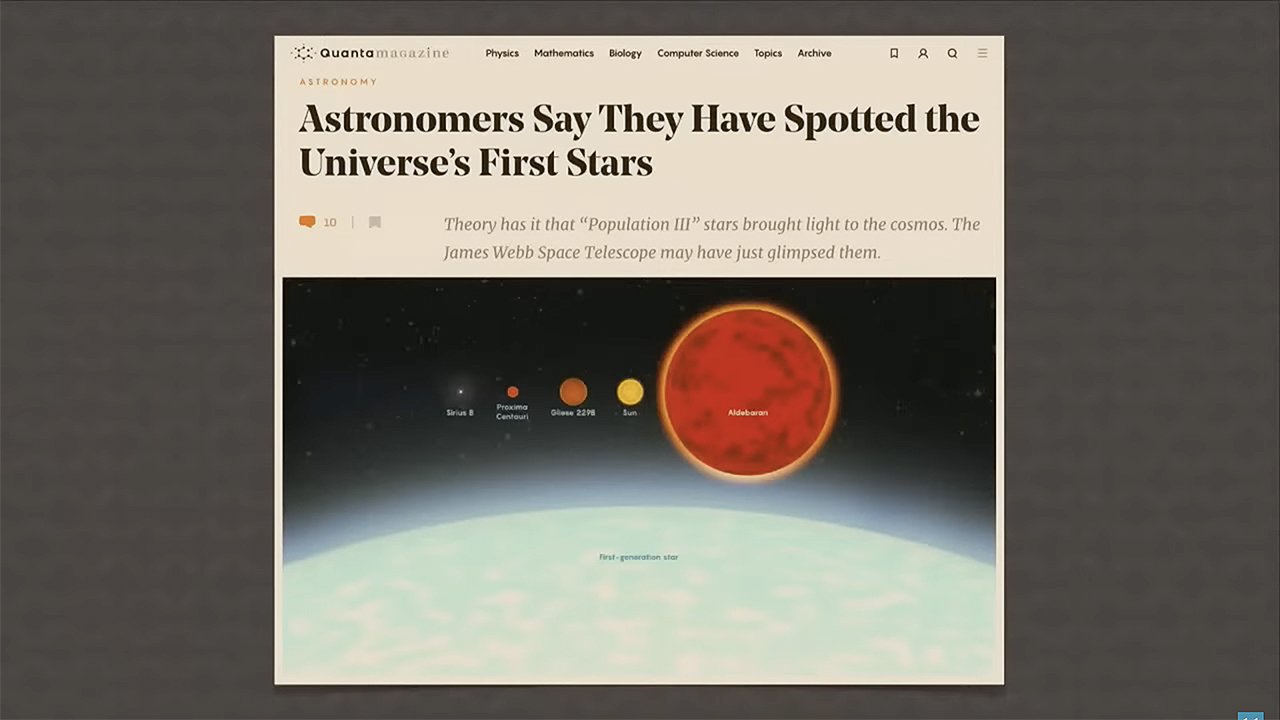
Have Our Universe’s First Stars Finally Been Spotted?
Ever since the first images from the James Webb Space Telescope began arriving in July, 2022, astronomers have been eagerly poring over never before seen views of stars, galaxies, and more in deep outer space for insights into our universe, particularly its supposed origins. And one particular object which evolutionary astronomers are desperate to find is a so-called “first generation” star.
What Are “First Generation” Stars?
Now, what do they mean by a “first generation” star? Well, the big bang idea supposedly only produced the three lightest elements—hydrogen, helium, and trace amounts of lithium. But there are 100 or so other naturally occurring elements left to account for, so here’s how the evolutionary story goes: first generation (or Population III) stars produced the heavier elements in their cores as they exploded. These supernova explosions scattered the heavier elements throughout the universe, contaminating other stars (called Population II and I stars).
This isn’t just a minor problem. Such stars are essential to the evolutionary view of the origins of stars.
Now Population II and I stars are readily observed—just look up into the night sky or glance at our sun (a Population I star), and you’ll see them! But the supposed first generation (Population III) stars have never been observed, despite decades of intense search for them. This isn’t just a minor problem. Such stars are essential to the evolutionary view of the origins of stars.
So, given the stakes for the evolutionary worldview, with the newly released images from the James Webb Space Telescope, the race is on to peer (in the view of secular scientists) further back in time than we’ve ever looked before and find those Population III stars that simply must be out there. (As a side note, these researchers are not peering back in time—they are peering back in distance and assuming the time.)
Twinkle, Twinkle Little Star—There You Are . . . ?
And have scientists finally found these elusive stars? Well, one group of researchers claims they might have spotted “the first direct evidence” of these stars as they parsed apart light from ionized helium in a faraway galaxy. But, by their own admission, this interpretation is very tentative, with one researcher saying, “it’s not clean evidence” as “other piping hot cosmic objects can produce a similar helium II signature.” So, in other words, they observed ionized helium and are interpreting it as evidence of “first generation” stars, which it may or may not be.
Why So Desperate?
Now, I had to smile at this quote from the popular science writeup on this story. One researcher, commenting on the elusive nature of these “first generation” stars said, “We exist, therefore we know there must have been a first generation of stars.”
Here we get a rare glimpse into the presuppositions behind the search for evidence of the big bang and stellar evolution. The search isn’t really because the evidence demands it—after all, scientists have been searching for these “first generation” stars for decades with no results! It’s because the researchers observe that, well, we’re here, and they believe the only possible explanation for our existence is time and chance processes over millions of years, so there must be “first generation” stars out there. As we see so often, worldview drives your interpretation!
How Much Does It Matter?
The Bible doesn’t tell us which elements God put in which stars—it simply says he created them.
Now, in a biblical worldview, does it matter if the researchers find irrefutable evidence of Population III stars? No, the Bible doesn’t tell us which elements God put in which stars—it simply says he created them. While we don’t really expect Population III stars to exist, it’s not a problem if they do. But for the evolutionary worldview, these stars must exist, because the entire hypothesis of stellar evolution is predicated on it!
As astronomer Dr. Danny Faulkner explained in a blog post from a few years ago,
Whether or not astronomers amass clear evidence for Population III stars matters little to the creation model. However, the evolutionary model requires that Population III stars exist or once existed in abundance. . . . discovering Population III stars [in a specific galaxy Dr. Faulkner’s original post was looking at] does not solve all of the problems. There are many other galaxies and quasars at a similar distance (and hence viewed at a similar very early epoch in a big bang universe) . . . that show abundance of metals. For instance, many of them show clear evidence of dust, and dust necessarily is made of metals. Dust requires at least two generations of stars: at least one generation to produce the heavier elements and at least one generation to manufacture the dust particles from the metals. Where did the metals in these many other distant objects come from?
God Didn’t Use the Big Bang!
And it’s worth noting that this idea of stellar evolution is just another way the big bang is incompatible with biblical history. (Many Christians try to mix the two—but they don’t go together!) According to Genesis, God spoke, and untold billions of stars—including our sun—burst into existence at the same time. There weren’t millions of years between the creation of the first stars and the creation of supposed later stars. They all appeared instantaneously at God’s command.
According to Genesis, God spoke, and untold billions of stars—including our sun—burst into existence at the same time.
Stars didn’t evolve. They were created by an all-powerful God who simply speaks, and things come to be. It’s this God who is so great with majesty that he knows the number and name of each star (Psalm 147:4)—and yet is so close to us humans that he knows the number of hairs on our heads (Luke 12:7). Wow—what a mighty God we serve!
Get Close to the Heavens at the Creation Museum
If staring into the heavens—not to try to find evidence for evolutionary ideas, but rather to praise God for his phenomenal handiwork as the psalmist did (Psalm 19)—intrigues you, I encourage you to join us for an upcoming Stargazer’s Night at the Creation Museum with Dr. Faulkner. He is a wealth of knowledge, and, of course, presents with a biblical worldview perspective. You’ll love learning from him. Space is limited, so register today to save your spot.
Get More Answers on Answers News
This item was discussed yesterday on Answers News with cohosts Roger Patterson, Rob Webb, and Tim Chaffey. Answers News is our weekly news program filmed live before a studio audience here at the Creation Museum and broadcast on my Facebook page and the Answers in Genesis Facebook page. We also covered the following topics:
- The big bang idea is broken—wait, no it’s not—oh, yes, maybe it is!
- There are one million embryos stuck in “frozen orphanages.”
- Willing to kill unborn babies? California will fast-track your nursing license.
- And more!
Watch the entire episode of Answers News for February 8, 2023.
Be sure to join us each Wednesday at 2 p.m. (ET) on my Facebook page or the Answers in Genesis Facebook page for Answers News. You won’t want to miss this unique news program that gives science and culture news from a distinctly biblical and Christian perspective.
Thanks for stopping by and thanks for praying,
Ken
This item was written with the assistance of AiG’s research team.
Most Recent News
-
April 25, 2024 from Ken Ham Blog
A recent article made the bold claim that feathers are one of evolution’s greatest inventions. But what proof did they offer?
-
April 22, 2024 from Ken Ham Blog
Colorado law is all too happy to let medical staff prescribe the “abortion pill” (RU-486) to their patients, but it’s not so willing to allow for reversal.

Answers in Genesis is an apologetics ministry, dedicated to helping Christians defend their faith and proclaim the good news of Jesus Christ.
- Customer Service 800.778.3390
- © 2024 Answers in Genesis



